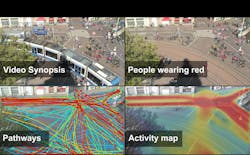Smart Cities are Safe Cities
For cities of all sizes, continually enhancing local quality of life is the driver of everyday city operations. Municipal leaders work tirelessly to meet the needs of current residents and businesses – while trying to attract new ones – planning and reinforcing activities that evoke a sense of physical security, efficient and effective management and economic prosperity. To overcome challenges, optimize productivity, increase public safety and drive long-term growth, forward-thinking cities are integrating Internet of Things (IoT) sensors and artificial intelligence (AI)-driven technological solutions.
Also known as smart cities, cities and towns seeking to leverage operational enhancement technologies, should be considering three factors when embracing solutions. As any municipal or law enforcement officer knows – resources are limited, so any technology selected must be cost-effective and designed to increase productivity moving forward. To that point, when cities consider technological investments, they should not only shop for new solutions but also take a critical look at existing integrations and evaluate which technologies could be leveraged differently to extract more value. For instance, the city might identify which solutions can provide data intelligence realizing that data is the cornerstone of the smart city technology stack. The smart city is one that plans and executes based on actionable intelligence, and, therefore, it selects enabling technologies with data extraction and analysis capabilities.
In this article, I’d like to discuss one technology that exemplifies the convergence of cost efficiency, infrastructure maximization and data optimization -- video content analysis based on video surveillance. Most cities and law enforcement already leverage video surveillance, mostly for security purposes, whether for combing footage for investigation evidence or city monitoring and situational awareness. With the basic infrastructure in place, cities can powerfully transform video into actionable intelligence by introducing video content analysis for supporting urban planning and traffic optimization, enhancing situational awareness and real-time response and promoting public safety and economic growth.
Urban Planning and Infrastructural Development
Video content analytics refers to a deep learning and artificial intelligence-driven technology that analyzes video to identify, track, extract and classify the objects that appear. This metadata is then indexed to enable users to search, act on and quantify the information derived from video content. For smart cities, video data is critical for empowering local law enforcement, streamlining everyday operations and planning for the future. When video data is aggregated, analyzed and visualized over time it becomes a valuable tool for uncovering patterns and preferences.
Cities and governments can review dashboards and reports that demonstrate how locals and visitors interact with infrastructure and can then leverage this intelligence to dynamically schedule maintenance, discover trends and plan for the future. For instance, urban planners might visualize path maps across a busy intersection to uncover the causes of congestion or accidents. Doing so could reveal a high rate of jaywalking and highlight the areas of the intersection where pedestrians are crossing. In this way, city planners can evaluate and determine the possible reasons pedestrians aren’t crossing at traffic lights or crosswalks: It could be that the light isn’t positioned in an optimal location or that there aren’t enough crosswalks or traffic lights in the space. With data visualizations, the planners can identify the inefficiencies and resolve them, pinpointing where to place new infrastructure based on typical pedestrian behavior and vehicular traffic trends.
Traffic Optimization and Congestion Prevention
Beyond identifying the need for new infrastructure, cities can leverage video content analysis for data-driven traffic optimization. From parking lots to pedestrian walkways to city roads, bike lanes and highways, video intelligence helps cities understand where bottlenecks occur, what causes them and how they can be alleviated.
Traffic data can be analyzed to pinpoint roads and parking lots that are underutilized but strategically placed. With this information, the city can determine how best to divert traffic from the main, congested roads and lots to equally functional alternatives, to increase throughput and prevent congestion. This data is especially critical for holiday weekends or planned events when high traffic is expected. Street closings and traffic diversions can be planned based on behavioral insights and known patterns to streamline movement for both vehicles and people. Comprehensive data analysis and visualization is a critical enabler, bolstering the city’s efforts to continually improve the quality of life.
Real-Time Response from Actionable Alerts
The insights provided by aggregated video data are valuable; however, often actionable intelligence is required to make decisions and streamline responses in real-time. For instance, while it’s helpful to prevent congestion on the roads or in a building based on long-term data analysis, it’s also critical to identify signs of building traffic or forming crowds, to intervene proactively. Video content analytics software can also be used for configuring real-time alerts to trigger calls to action for specific behaviors captured by video. When a pre-defined condition is met, a notification is sent so that an operator can make an assessment and determine the appropriate action.
While preparing for expected congestion around holidays, events and tourist seasons are crucial, real-time alerting capabilities can help cities maintain traffic when unexpected bottlenecks occur or start to build up. Cities can powerfully utilize both past intelligence and real-time data, to proactively ensure steady movement throughout the area’s main roads, side streets, parking lots and public transport systems. For example, an alert can be triggered if the number of cars exiting the local highway exceeds a certain number within a specified time frame. An operator could assess the data to understand the causes of anomalous behavior and determine whether an action is necessary. If need be, police can be immediately notified and mobilized to respond to an accident or direct traffic.
Alerts can also notify police of traffic violations, such as cars making illegal turns or U-turns and, thus, better enforce traffic laws. From stationing police or issuing tickets to deter misbehavior from updating infrastructure to prevent these violations, video data helps uncover the long-term trends and real-time occurrences that warrant a response.
Of course, real-time alerting is also crucial for notifying the authorities of more egregious behavior: Crime has a major impact of a city’s ability to attract new residents, visitors and businesses. Too much criminal activity can both curtail long-term economic development and create distrust between the community and local law enforcement, so it is critical to empower the police with technology to drive immediate and preventative response to criminal and suspicious behaviors, reinforcing a sense of public safety and well-being.
Real-time video analytics alerts can be configured for detecting activity at unusual hours, for instance, enabling the system’s operator to determine whether police need to be mobilized to investigate further. The same software can also be used to pinpoint stolen vehicles, providing alerts any time a vehicle is detected that matches the color and vehicle type defined in the alerting criteria. Finally, this technology can be powerfully applied to quickly identify missing persons to recover and reunite them with their parties. If a child goes missing, the police can define video alerts, triggering notifications for children detected wearing clothing that matches the child’s description.
Video Analytics-Driven Facial Recognition
As higher resolution cameras continue to proliferate, face recognition technology is becoming more accurate and, thus, a more compelling capability for law enforcement. With today’s artificial intelligence-backed solutions, users can create watchlists with digital images – either from video or other sources – and then configure alerts anytime a match for that person is detected. An operator can then assess the accuracy of the match and determine the appropriate real-time response. More targeted than appearance similarity alerting, face recognition alerting enables law enforcement to respond when missing persons and suspects are detected and to track their movements in critical, time-sensitive circumstances.
Cities could leverage the ability to detect, track and trigger alerts for persons-of-interest to increase public safety at mass events. When past aggravators are detected on-site, police can be deployed to more closely monitor these individuals and prevent aggression and aggravation. Similarly, this technology can be utilized to detect the presence of past sexual offenders at school or park perimeters and to monitor their behavior to ensure that children are not in danger.
Investigation Acceleration and Evidence Collection
When crime cannot be prevented, a swift investigation is key for restoring local security and recovering from the impact of the crime. In the aftermath of a security breach or public safety incident, law enforcement is tasked with understanding the event, determining whether the perpetrators are still at large and apprehending them to prevent future unrest. By making video easily searchable, video analysis enables police to quickly investigate and review video to fully understand the event and search video for specific objects. In the case of a public attack, police can immediately review and comprehend how the situation developed – leveraging video recordings from multiple cameras and days – pinpoint the suspected perpetrators within video and then mobilize strategically to contain the damage and prevent additional events. Without video analysis, reviewing this content would demand significant manpower and time, but by streamlining video review and search, video evidence can be extracted within minutes and cases can be solved faster.
Video analysis is critical because it helps accelerate investigations regardless of whether a suspect has been identified. If there is a known suspect, operators can forensically use face recognition to rapidly pinpoint specific individuals and then continue tracking their movements with real-time alerting, until they are apprehended. Currently, cities and governments are navigating how to balance the technology’s significant public safety benefits with the concerns about broadly integrating biometric-enabled security systems. These considerations are likely to be resolved as more regulation guiding and governing the use of the technology is formalized. Certainly, cities that leverage these powerful solutions must do so following applicable laws, responsibly and transparently ensuring full compliance with privacy and data protection regulations. The ability to pinpoint specific individuals powerfully accelerates real-time response and post-event investigation, but it is merely one solution in the robust video analysis toolbox that each city can embrace based on its needs and local legislation.
Scalable Solutions for Evolving Challenges
From law enforcement to the residents, businesses and visitors they protect, as well as the city planning and operational management agencies, video content analysis is a powerful solution for addressing the needs of diverse stakeholders. Driving more agile policing, city operations management and real-time response when it matters most, video analytics software continues to become more essential to city operations, public safety and the charge toward a tech-enabled future. Motivated to reinforce security and sustainability, based on data resources and existing infrastructure, while balancing cost limitations, the city can advance and scale its multifaceted objectives by investing in comprehensive and extensible solutions, such as video analytics. Enabling full maximization of a single integration, video analytics technology empowers cities to scale and expand video surveillance activity based on the city’s developing and evolving needs.
About the author: Stephanie Weagle is the CMO of BriefCam and leads its global marketing initiatives and accelerates market adoption of its industry-leading video analytics solutions. Before joining BriefCam, Stephanie was Vice President of Marketing for Corero Network Security, where she led global marketing for the company’s cyber-threat mitigation product portfolio. Previously, Stephanie held senior marketing roles at Lionbridge Technologies and Novell, Inc.
About the Author

